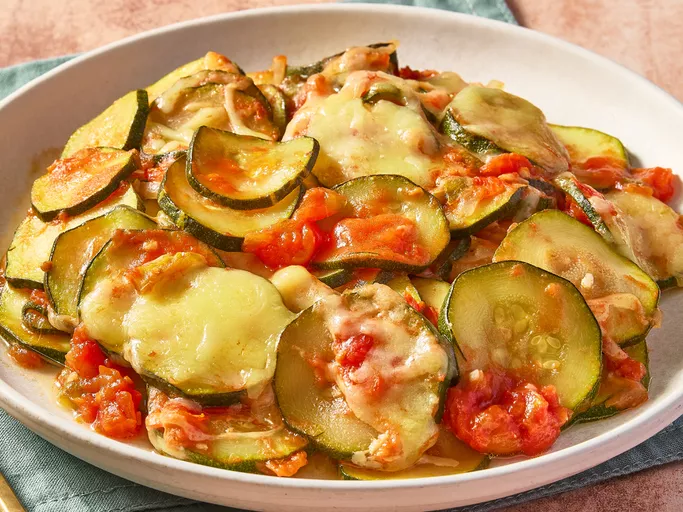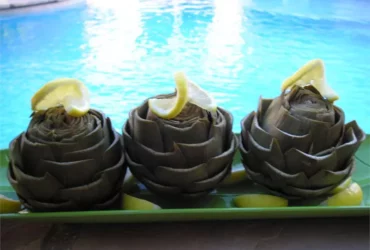Ingredients
Zucchini
- Zucchini, also known as courgette or baby marrow, is a popular summer squash that belongs to the Cucurbitaceae family.
- It is a versatile and nutritious vegetable that is widely cultivated and consumed in many parts of the world, particularly in Mediterranean countries such as Italy, Greece, and Spain.
- In Mexico, where Calabacitas Guisada originates from, zucchini is known as “calabacita” or “zapallito,” and is a common ingredient in various traditional dishes, including soups, stews, salads, and main courses.
- From a culinary standpoint, zucchini has several desirable characteristics that make it an ideal ingredient for cooking.
- Its mild flavor and soft texture allow it to absorb the flavors of other ingredients and seasonings, making it an excellent choice for stir-fries, sautés, and braises.
- Additionally, zucchini is low in calories but rich in essential nutrients, including vitamin C, potassium, magnesium, and fiber, which makes it a healthy addition to a balanced diet.
- In terms of varieties, there are several types of zucchini available, each with its unique characteristics and flavor profiles.
The most common varieties include:
- Straight neck zucchini: This is the most widely cultivated variety, characterized by its straight cylindrical shape and light green skin.
- Crookneck squash: This variety has a curved or bent neck, with a slightly sweeter flavor than the straight neck zucchini.
- Patty pan squash: A small, flat variety of zucchini that is often used in salads and sautés.
- When selecting zucchinis for Calabacitas Guisada, look for straight neck or crookneck varieties, as they are the most suitable for stews and braises.
- Choose medium-sized zucchinis with a firm skin and no signs of soft spots or mold.
- Avoid zucchinis that are too large, as they may be fibrous and lack flavor.
- In terms of storage, zucchinis are best stored in the refrigerator to keep them fresh for up to 3-5 days.
1 medium to large zucchini
The first ingredient required for Calabacitas Guisada, a traditional Mexican dish, is one medium to large zucchini. The selection of the right size and type of zucchini is crucial in achieving the desired flavor and texture of the stewed zucchini.
A medium-sized zucchini typically weighs between 8-10 ounces (225-280 grams) and has a diameter of about 2-3 inches (5-7.6 centimeters). It should have a smooth, glossy exterior with slightly tender skin. The flesh of the zucchini should be firm but yielding to pressure.
The ideal zucchinis for this recipe are those that are dense and not too seedy or fibrous. The most common types of zucchini used in Mexican cuisine are the ‘Zabi’ or ‘Pattypan’ varieties, which have a slightly sweeter flavor and firmer texture than other types.
When choosing a medium to large zucchini for Calabacitas Guisada, look for one that is free from bruises and soft spots. The stem end of the zucchini should be firm and green, while the blossom end can be slightly softer but still firm.
Remember that zucchinis are highly perishable vegetables and will continue to grow in size as they age. For best flavor and texture, use a medium to large zucchini within 1-2 days of purchase or harvest it from your garden at the ideal size for the recipe.
1/4 cup water
The key to a delicious and flavorful Calabacitas Guisada, also known as Stewed Mexican Zucchini, lies in the selection of high-quality ingredients.
Here are the essential components you will need for this recipe:
- Zucchini: This is the main ingredient and should be chosen based on its freshness and firmness. For Calabacitas Guisada, it’s ideal to use young zucchinis, about 8-10 inches in length.
- Onions: You will need one medium-sized onion, peeled and chopped into small pieces. For added flavor, use a red onion if available.
- Garlic: Three to four cloves of garlic, minced, will provide the necessary pungency for this dish. You can also use green garlic if you prefer a milder flavor.
- Tomatoes: Use two medium-sized tomatoes, cored and chopped. You can also use canned crushed tomatoes as a substitute.
- Cilantro: This herb is an essential component of Mexican cuisine, and you will need a handful of chopped fresh cilantro.
- Lime juice: Use the juice of one lime to add a touch of acidity and freshness to this dish.
- Salt and pepper: These are the traditional seasonings used in Mexican cooking, and you will need them to taste.
- Cumin powder: This is a staple spice in Mexican cuisine, and you will need about half a teaspoon of cumin to add depth and warmth to this dish.
- Mexican oregano: This herb adds a distinct flavor to many traditional Mexican dishes, including Calabacitas Guisada. Use about half a teaspoon of Mexican oregano for this recipe.
- Water: You will need about one-quarter cup or 250 milliliters of water to help simmer the ingredients together and create a rich, flavorful broth.
Once you have all these ingredients on hand, you can proceed to prepare this delicious Calabacitas Guisada recipe and enjoy it with tortillas or as a side dish for your favorite Mexican meals!
Seasonings
The key to a flavorful and authentic Calabacitas Guisada lies in the choice and combination of ingredients, particularly the seasonings used to enhance the natural taste of zucchini. A classic recipe typically includes the following essential ingredients:
Zucchini (calabacita) – Fresh or frozen, this is the main component of the dish. Choose firm, bright green zucchinis with no signs of wilting or browning.
Onion – Chopped onion adds a sweet and savory flavor to the stew. Opt for yellow or white onions for their mild sweetness.
Garlic – Like onion, garlic contributes to the depth of flavor in the dish. Use 1-2 cloves, minced or crushed, depending on your preference for pungency.
Cilantro (coriander) – Also known as Mexican parsley, cilantro has a distinctive citrusy and herbal taste that pairs well with zucchini. Add fresh cilantro leaves towards the end of cooking to preserve their flavor and aroma.
Ground cumin – This earthy and warm spice is commonly used in Mexican cuisine to add depth and richness to dishes like Calabacitas Guisada.
Paprika (or chili powder) – Optional, but adds a smoky or slightly spicy flavor to balance the sweetness of zucchini. Use mild or hot paprika depending on your taste preference.
Tomato paste or crushed tomatoes – Adding tomato products gives the stew a tangy and slightly acidic flavor. Choose between plain tomato paste, crushed tomatoes, or fresh chopped tomatoes for their texture and juiciness.
Lime juice – A squeeze of fresh lime juice at the end adds brightness to the dish, balancing its sweetness with an invigorating acidity.
Salt and black pepper – These two seasonings enhance the natural flavors of the ingredients and add balance to the dish. Use them liberally but taste as you go to adjust seasoning according to your preference.
Vegetable oil or lard – A small amount of neutral-tasting oil or animal fat is necessary for sautéing the aromatics at the start of the recipe.
Optional ingredients might include diced bell peppers, chopped fresh epazote leaves (a pungent herb used in some Mexican recipes), or cooked beans to add protein and fiber. The choice of these optional ingredients depends on personal taste and regional preferences within Mexico.
1 teaspoon ground cumin
Cumin is a key spice commonly used in many international cuisines, particularly in Mexican, Middle Eastern, and Indian cooking.
Ground cumin has a warm, earthy flavor that adds depth to dishes without overpowering them.
The spice is derived from the seeds of the Cuminum cyminum plant, which is native to the Middle East and South Asia.
Cumin seeds are usually harvested when they are mature but still green, then dried either naturally in the sun or using machines to remove excess moisture.
After harvesting and drying, cumin seeds are ground into a powder, typically using large industrial grinders that can produce high volumes of product quickly.
The resulting ground cumin is a key component in many spice blends, including chili powders, curry powders, and tacos seasoning mixes.
In the context of the Calabacitas Guisada recipe, 1 teaspoon of ground cumin serves as an essential flavor enhancer that complements the natural sweetness of the zucchini.
When cooking with cumin, it is essential to note that this spice can be quite potent, so a small amount is usually recommended to avoid overpowering other flavors in a dish.
In general, ground cumin pairs well with ingredients like onions, garlic, tomatoes, and cilantro, all of which are commonly used in Mexican cooking.
1 teaspoon paprika
Paprika is a spice made from ground dried fruit pods of the sweet or bell pepper plant, Capsicum annuum. It comes in various colors depending on the level of ripeness when picked and processed. The most commonly used types of paprika are sweet, smoked, and hot.
The sweet type has a mild flavor and is often used as a coloring agent in cooking. It’s a popular choice for adding depth and warmth to dishes without any overpowering heat. Sweet paprika is typically made from red bell peppers that have been picked when they’re fully ripe and then dried.
Smoked paprika, also known as pimenton, has a smoky, slightly sweet flavor and is often used in Mediterranean and Southwestern cooking. It’s usually made from roasted red peppers that have been smoked over oak wood fires before being ground into a fine powder.
Hot paprika has a spicy, fiery flavor and is typically made from hotter varieties of bell peppers. This type of paprika is often used to add heat to dishes without overpowering the other flavors. When using hot paprika, it’s essential to start with small amounts as it can quickly overwhelm the taste buds.
In the context of Calabacitas Guisada’ (Stewed Mexican Zucchini) Recipe, a teaspoon of sweet paprika adds a subtle smoky flavor that complements the zucchini and other ingredients without overpowering them. The mild heat from the paprika also enhances the overall flavor experience.
Salt and pepper, to taste
To prepare the delicious Calabacitas Guisada, a classic Mexican dish, you’ll need to gather the following ingredients:
- 4 medium-sized zucchinis
- 1 small onion, chopped
- 2 cloves of garlic, minced
- 1 teaspoon ground cumin
- 1/2 teaspoon paprika
- 1/4 teaspoon black pepper
- 1/4 cup vegetable oil or lard
- 2 cups water or chicken broth
- 1 tablespoon chopped fresh cilantro (optional)
Salt and Pepper:
- Celery Salt: This type of salt is coarser in texture than regular table salt. It’s often used as a finishing salt, adding flavor to dishes just before serving.
- Black Pepper: This essential spice adds depth and heat to Calabacitas Guisada. Use whole peppercorns or pre-ground black pepper for added convenience.
When it comes to seasoning with salt and pepper, the phrase ‘to taste’ means using your personal preference as a guide. This allows you to adjust the flavor levels according to your liking. Some people prefer their Calabacitas Guisada very lightly seasoned, while others like a more robust flavor.
When using ‘to taste,’ keep in mind that a pinch of salt and a few grinds of black pepper can go a long way in enhancing the dish’s overall flavor profile.
To incorporate salt and pepper into your Calabacitas Guisada, you can add them:
- As the dish cooks: Add a pinch of salt and some black pepper to the pot as the zucchinis simmer. This will help season the dish evenly throughout.
- Before serving: Sprinkle a pinch of salt and some black pepper over the Calabacitas Guisada just before serving. This adds an extra layer of flavor and aroma.
Remember, when it comes to seasoning with salt and pepper, ‘to taste’ is not a set amount – it’s a suggestion that you can adjust according to your personal preferences.
Pan-Fried Onions and Garlic
Instructions
The addition of pan-fried onions and garlic to Calabacitas Guisada’ elevates this traditional Mexican dish, infusing it with an intense depth of flavor. To create this aromatic component, you will need the following ingredients:
- 2 large onions
- 4-5 cloves of garlic
- 2 tablespoons of vegetable oil (such as canola or olive oil)
- 1 teaspoon of salt
- 1/2 teaspoon of black pepper
To start, peel the onions and place them in a bowl with enough cold water to cover. Let them soak for at least 30 minutes to remove some of their pungency and make them easier to cook.
Peel the garlic cloves and set them aside. If you have a microplane or fine grater, use it to grate the garlic into thin strips; otherwise, you can simply chop the garlic into small pieces.
After soaking, drain the onions and pat them dry with paper towels to remove excess moisture. This step helps prevent the onions from releasing their water too quickly when cooked, which would lead to a steamed texture rather than a nicely caramelized one.
Heat the oil in a large skillet over medium heat until it shimmers. Carefully add the soaked and drained onions to the pan, trying not to overcrowd them. You may need to cook them in batches depending on your pan’s size. Sprinkle the onions with salt and pepper to help bring out their natural sweetness.
Allow the onions to cook for about 10-12 minutes or until they are deep golden brown and slightly caramelized, stirring occasionally to prevent burning. You might need to adjust the heat if you notice them browning too quickly.
Add the grated garlic to the pan in the last 2-3 minutes of cooking, so it has a chance to soften and infuse the onions with its pungency without overpowering the dish. Stir the mixture constantly until the garlic is fragrant but not burnt.
Once both the onions and garlic are cooked, remove them from heat and let them cool slightly before adding them to your Calabacitas Guisada’. This aromatic mixture will enhance the flavors of the zucchini and other ingredients in this classic Mexican recipe.
Heat oil in a large skillet over medium heat
The aromatic and flavorful addition to many dishes, Pan-Fried Onions and Garlic are a staple in Mexican cuisine, particularly in the preparation of Calabacitas Guisada’, or Stewed Mexican Zucchini.
To prepare this essential component, start by heating oil in a large skillet over medium heat. This is usually done using vegetable oil, such as canola or olive oil, as they have a high smoke point and won’t break down when heated to medium temperatures.
While the oil heats up, slice an onion into thin rings. It’s best to use a sweet onion variety, like Vidalia or Maui, which will caramelize well without adding bitterness to your dish.
Next, chop some garlic cloves, using about three cloves per skillet full of onions. You can use more or less, depending on your personal preference for garlic flavor.
Mince the garlic in a fine texture so it cooks evenly with the onions and adds a rich depth to the sauce of Calabacitas Guisada’.
Once the oil is hot enough to sizzle when you add the first onion ring, carefully place all of the sliced onions in the skillet.
Pour a little bit of salt over the onions to help bring out their natural sweetness. You can also sprinkle some sugar if you prefer your onions caramelized to be sweeter.
Now, cook the onions for about 20 minutes or until they reach the desired level of browning and caramelize. Stir them occasionally to ensure even cooking and prevent burning.
While the onions are cooking, prepare your other ingredients according to the recipe, which includes chopping zucchinis, bell peppers, tomatoes, and any spices you choose to add to your Calabacitas Guisada’.
Once the onions have caramelized to a deep golden brown color, add in the minced garlic. Be careful not to let it burn by stirring constantly for about one minute or until fragrant.
Add in the prepared vegetables and any additional seasonings you’re using, then stir well to combine with the pan-fried onions and garlic.
Continue cooking Calabacitas Guisada’ on medium heat, allowing all the flavors to meld together as it cooks for about 10-15 minutes or until the zucchinis are tender. You can serve this dish hot, garnished with a sprinkle of queso fresco, chopped fresh cilantro, and a squeeze of lime juice.
With these basic steps for pan-frying onions and garlic, you’re well on your way to making delicious Calabacitas Guisada’ and other Mexican dishes that highlight the flavors of this essential combination.
Key Tips:
- Use a medium heat setting when heating oil in the skillet to prevent it from smoking or burning.
- Choose sweet onion varieties, like Vidalia or Maui, for better caramelization and flavor.
- Add salt and sugar sparingly, according to your taste preferences, when cooking onions to enhance their natural sweetness.
- Cook the garlic carefully for about one minute after adding it to prevent burning and preserve its aroma and flavor.
Add onions and cook until softened
To enhance the flavor and texture of our Calabacitas Guisada, a traditional Mexican dish, we can add some caramelized pan-fried onions and garlic as a crucial component.
The process begins with preparing the necessary ingredients: thinly slice 1 large onion and separate it into individual rings. Additionally, peel and mince 2-3 cloves of garlic to be ready for cooking.
Next, heat about 2 tablespoons of oil in a medium-sized skillet over medium heat. Once the pan is warm, add the sliced onions. It’s essential to spread them evenly across the surface to ensure they cook uniformly.
Allow the onions to cook and soften gradually, which can take anywhere from 15 to 20 minutes depending on their thickness and your desired level of caramelization. You may need to occasionally stir or toss them gently with a spatula to prevent burning and promote even browning.
As the onions reach a golden-brown color, remove them from heat temporarily and set them aside for later use. Proceed by adding minced garlic to the same skillet and sauté it over low heat until fragrant. Be cautious not to burn the garlic as it can quickly become bitter if cooked too long.
Once the onions have cooled slightly, you can combine them with the cooked garlic in a bowl or directly into our Calabacitas Guisada recipe for added depth and richness of flavor.
This step is crucial for bringing all the elements together in harmony. By pan-frying the onions until they’re soft and sweet, we add a subtle layer of texture that complements the tender zucchini perfectly. Meanwhile, the garlic contributes its signature pungency to create an aromatic base that elevates the entire dish.
By incorporating these caramelized onions and garlic into our Calabacitas Guisada recipe, we can be sure to achieve a truly authentic Mexican flavor profile with every bite.
Add garlic and cook for an additional minute
The addition of pan-fried onions and garlic to the Calabacitas Guisada recipe adds an incredible depth of flavor and aroma to this traditional Mexican dish.
To prepare the pan-fried onions, heat about 1-2 tablespoons of oil in a large skillet over medium-low heat. Add 1 medium onion, thinly sliced, and cook for about 15-20 minutes or until they are lightly browned and caramelized. Stir occasionally to prevent burning.
For the garlic, use 3-4 cloves, peeled and minced. After cooking the onions for 5 minutes, add the minced garlic and continue to cook for an additional minute. Be careful not to burn the garlic, as it can quickly become overpowering. The aroma of sautéed garlic will fill your kitchen, and it’s essential to get it just right.
The reason we add the garlic after 5 minutes is that cooking it too early can make it bitter or unpleasantly strong. By adding it towards the end of the onion’s cooking time, the heat from the pan still cooks the garlic through but allows its delicate flavor and aroma to shine.
When you’ve finished cooking your onions and garlic, they should be soft, fragrant, and slightly browned. You can use them as a topping for your Calabacitas Guisada or mix them into the stew itself. They add an incredible richness and complexity that complements the flavors of the zucchini, tomatoes, and spices.
This process not only adds flavor but also helps to mellow out some of the pungency from both onions and garlic. Cooking them slowly over low heat breaks down their cellular structure, making them easier to digest and adding an incredible depth of flavor to your dish.
- Best Datanyze Alternatives for 2025 - April 24, 2025
- Best Hunter.io Alternatives for 2025 - April 22, 2025
- Best Lead411 Alternatives for 2025 - April 22, 2025















